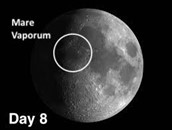The week of August 29 – September 4 takes us from Lunar Day 3 to Day 9. This week we will highlight Mare Vaporum, viewable on Saturday evening.
 Mare Vaporum: [NE/H10; L=4°E] Notice how there are finger-like projections extending from the back side of the Apennines into Mare Vaporum. It is not coincidental that these extensions point back to Mare Imbrium as they are part of the ejecta that was thrown out during the initial impact. (This also makes the Sea of Vapors considerably younger than Mare Imbrium.) Notice how the lava seas have flowed smoothly into the bays and fjords of the Apennine Mountains. This is a clear indication that the Apennines were in place long before the lava seas flowed into the Mare Vaporum depression.
Mare Vaporum: [NE/H10; L=4°E] Notice how there are finger-like projections extending from the back side of the Apennines into Mare Vaporum. It is not coincidental that these extensions point back to Mare Imbrium as they are part of the ejecta that was thrown out during the initial impact. (This also makes the Sea of Vapors considerably younger than Mare Imbrium.) Notice how the lava seas have flowed smoothly into the bays and fjords of the Apennine Mountains. This is a clear indication that the Apennines were in place long before the lava seas flowed into the Mare Vaporum depression.
Take a comparative look at Mare Vaporum and Sinus Medii. It should be obvious which is younger. What do you think?1
OF ADDITIONAL INTEREST IN SPACE:
September 1, 1979, Pioneer 11 becomes the first spacecraft to fly past Saturn.
September 3, 1976, Viking 2 lands on Mars.
1 The Sea of Vapors is younger—the simple reason being that its floors are smoother. Over a longer time the floor of Vapors would have accumulated more meteor impacts.
======================
It is highly recommended that you get a copy of Sky and Telescope’s Field Map of the Moon, the very finest Moon map available for use at the telescope. It is available for $10.95 at www.skyandtelescope.com and on Amazon. All features mentioned in this blog will be keyed to the grid on the Field Map and will look like this: Plato: [NW/D9]
Credits:
Courtesy of Gray Photography of Corpus Christi, Texas
Lunar photos: NASA / USGS / BMDO / LROC / ASU / DLR / LOLA / Moon Globe. Used by permission
- Rupes Cauchy: A Best Known Fault on the Moon - July 22, 2024
- Moon Crater Schickard – Crater Floor has Stripes - July 15, 2024
- Moon Craters Langrenus and Vandelinus - July 8, 2024